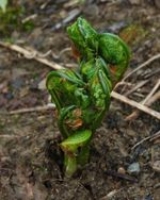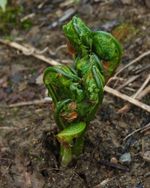
Sansai
Encyclopedia


Japanese language
is a language spoken by over 130 million people in Japan and in Japanese emigrant communities. It is a member of the Japonic language family, which has a number of proposed relationships with other languages, none of which has gained wide acceptance among historical linguists .Japanese is an...
word literally meaning "mountain vegetables", originally referring to vegetables that grew naturally in the wild and were not cultivated. However in modern times, the distinction is somewhat blurred, as some sansai such as warabi have been successfully cultivated. Sansai are often used as ingredients in shōjin ryōri
Buddhist cuisine
Buddhist cuisine is an East Asian cuisine which is followed by some believers of Buddhism. It is primarily vegetarian, in order to keep with the general Buddhist precept of ahimsa...
, or Buddhist vegetarian cuisine.
Sansai include:
- FukiFukiPetasites japonicus, also known as Fuki, bog rhubarb, or giant butterbur, is an herbaceous perennial plant in the family Asteraceae. It is native to Japan, where the spring growth is relished as a vegetable...
noto - Gyojyaninniku
- KogomiOstrich fernThe ostrich fern or shuttlecock fern is a crown-forming, colony-forming fern, occurring in temperate regions of the Northern Hemisphere in eastern and northern Europe, northern Asia and northern North America....
- Koshiabura
- Mitsuba
- Seri
- Tara no Me
- UdoAralia cordataAralia cordata is an upright herbaceous perennial plant growing up to 2-3 m in height, native to Japan, Korea and eastern China. It is known as Udo in Japanese, and also as Japanese Spikenard...
- WarabiPteridium aquilinumPteridium aquilinum is a species of fern occurring in temperate and subtropical regions throughout much of the northern hemisphere....
- Zenmai

